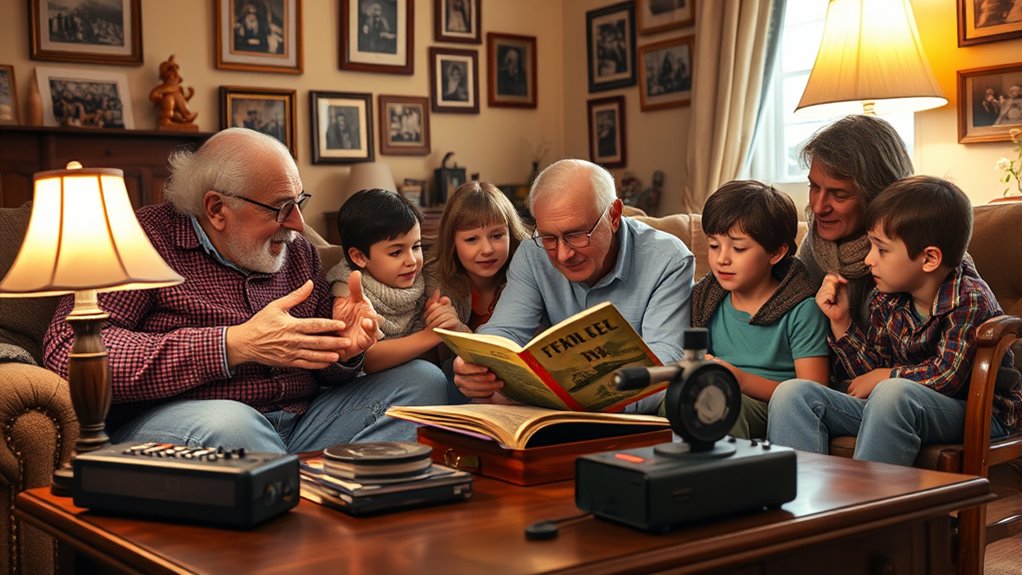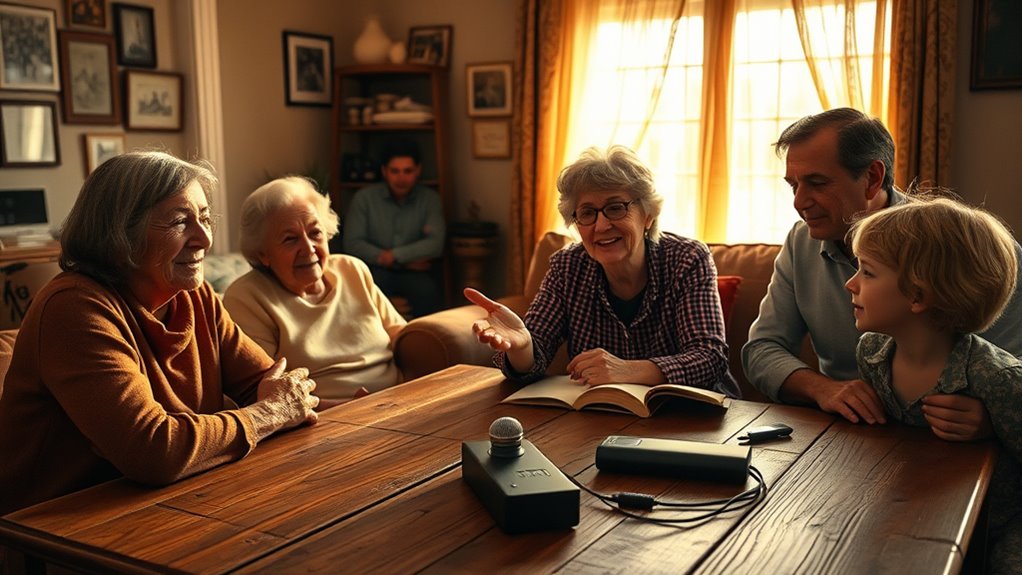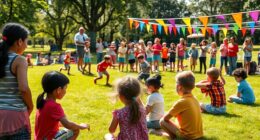Family storytelling is essential for preserving oral history. It helps you understand your identity and strengthens family ties through shared narratives. By recording these stories, you capture cultural values, customs, and personal histories that connect generations. To preserve these narratives, you can use best practices like careful listening and quality recording. However, challenges like cognitive decline and technological failures can threaten these stories. Want to discover effective techniques and resources for enriching your storytelling?
Key Takeaways
- Family storytelling enhances emotional well-being and strengthens bonds, providing a sense of belonging and identity for both children and adolescents.
- Recording oral histories requires high-quality equipment, quiet environments, and informed consent to ensure clarity and respect for the interviewee.
- Capturing rich narratives preserves cultural values and customs, connecting generations and ensuring traditions are passed down effectively.
- Challenges such as cognitive decline, procrastination, and technological vulnerabilities threaten the preservation of family narratives over time.
- Effective storytelling techniques, like engaging hooks and vivid imagery, can enhance the impact and memorability of shared family stories.
The Significance of Family Storytelling

Family storytelling holds immense significance in shaping our identities and strengthening our bonds. By sharing family stories, you help your children understand their place within the family and their heritage.
These narratives provide concrete examples of values and beliefs that kids can incorporate into their lives. Research shows that adolescents familiar with their family’s history often experience greater emotional well-being and a stronger sense of identity. Additionally, family stories serve as guides for facing fears and challenges, providing children with examples of resilience.
When children hear about their parents’ experiences, they gain insights to navigate their own challenges. Plus, feeling connected to family stories boosts their sense of belonging and self-esteem.
Ultimately, storytelling creates a foundation for emotional connections and continuity, enriching both individual and collective family memories.
Best Practices for Recording Oral Histories

Recording oral histories can be a rewarding process that brings family stories to life, but it requires careful preparation to guarantee the best results.
Start by conducting background research on your interviewee and the historical context to enrich the conversation. Set clear goals for the interview to guide your questions effectively. Use high-quality recording equipment, like external microphones, in quiet locations to ensure clear audio. It is essential to remember that audio recording serves as the primary record of an oral history interview.
Before recording, obtain informed consent from the interviewee. When you begin, introduce the date, location, and participants.
During the interview, practice non-interruptive listening and ask clear, concise questions to encourage detailed responses. Allow silences for reflection, and make certain to clarify names and places for accuracy.
The Role of Oral History in Cultural Preservation

While many might think of history as a series of dates and events, oral history plays an essential role in cultural preservation by capturing the rich narratives that define communities.
For thousands of years, cultures like Native American tribes and Australian Aboriginal peoples have relied on oral storytelling to convey their values, customs, and collective memories. Through riddles, proverbs, and epic songs, these narratives connect generations and strengthen cultural roots. Recording life stories contributes to the preservation of cultural heritage and ensures that traditions are passed down to future generations. Additionally, the sharing of global flavors through food stories can deepen the connection between cultural practices and personal histories. Spiritual principles often embedded in these stories serve to inspire and uplift individuals, reinforcing the values that bind communities together.
Challenges in Preserving Family Narratives

Preserving family narratives presents several challenges that can hinder the continuity of storytelling traditions.
Limited information often plagues older generations, and cognitive decline can erase valuable narratives if not documented early. You might find yourself procrastinating on documenting your family’s stories, but this delay can lead to loss over time.
Digital records, while convenient, are vulnerable to technological failures, risking the preservation of memories. Generational breakdowns can further complicate storytelling, as younger family members mightn’t engage deeply. Additionally, changing cultural attitudes can affect how these stories are perceived. Oral traditions serve as a means of cultural identity and continuity, highlighting the importance of acting promptly to preserve these narratives. If you don’t act promptly, memories will fade, and the urgency to preserve these narratives might only hit you when it’s too late.
Techniques for Effective Storytelling

Effective storytelling techniques can transform family narratives into engaging experiences that resonate with listeners. Consider using the monomyth structure to outline a hero’s journey or the mountain structure to build tension and drama.
Starting your story in medias res can hook your audience right away. Layering stories with nested loops emphasizes central messages, while the petal structure converges multiple tales around a theme.
Authenticity and vulnerability make your storytelling relatable, while adaptability lets you respond to audience engagement. Use compelling hooks, clear narratives, and expressive body language to captivate.
Practice regularly for improvement, and don’t shy away from audience feedback. Finally, incorporate rhetorical questions and vivid imagery to enhance your narrative and keep listeners invested.
Platforms and Resources for Oral Histories

Storytelling isn’t just about the techniques you use; it’s also about where and how you share those stories.
Online platforms like Ancestry.com and FamilySearch.org help you build family trees and access historical records. For personal narratives, StoryCorps provides a mobile app for recording interviews, while StoryWorth turns your family’s tales into beautiful bound books.
If you’re looking to enhance your recordings, audio editing software and transcription tools are invaluable. Local historical societies and online courses offer workshops on genealogy and oral history techniques.
Don’t forget about archiving resources like the Oral History Association’s guidelines and digital archives to preserve your interviews. Each resource you choose adds depth to your family’s storytelling journey.
The Future of Family Storytelling and Preservation

As technology continues to evolve, the landscape of family storytelling is transforming, making it easier than ever to share and preserve cherished narratives. Digital tools now enable multimedia integration, allowing you to create engaging stories that resonate across generations.
With families becoming more dispersed, these innovations are vital for maintaining connections and safeguarding cultural heritage. Younger generations can actively participate, guaranteeing storytelling continues to thrive.
However, challenges like digital overload and accessibility remain. By embracing innovative formats such as podcasts and virtual reality, you can revitalize storytelling.
Collaborating with diverse voices guarantees that everyone’s story is respected. Ultimately, preserving family histories fosters emotional connections, cultural continuity, and a lasting legacy for future generations.
Frequently Asked Questions
How Can I Encourage Reluctant Family Members to Share Their Stories?
To encourage reluctant family members to share their stories, create a relaxed atmosphere where they feel comfortable.
Start by highlighting the importance of their experiences and the bonds storytelling can foster. Use open-ended questions to spark meaningful conversations, and respect their boundaries by letting them choose how much to share.
Share positive examples from others to inspire them, and be patient and flexible as they warm up to the idea of storytelling.
What Should I Do if I Miss Recording an Important Story?
Imagine a flickering candle, its light fading just as an essential story slips away.
If you miss recording that essential tale, don’t despair! Reach out to the storyteller soon, while memories are still fresh.
Ask them to recount the story again, perhaps over a warm cup of tea. Supplement with family records or photos to jog their memory.
Keep a journal handy to capture those precious details this time.
How Do I Handle Sensitive or Painful Family Stories?
When handling sensitive or painful family stories, start by gauging the story’s sensitivity.
It’s essential to have a family liaison to help navigate the conversation. Show empathy and maintain a non-judgmental stance, ready to pause if the narrator feels uncomfortable.
Be prepared for unexpected emotional responses and plan for follow-up discussions.
Respect the narrator’s authority over their story, and guarantee you approach each topic with care and understanding.
Can I Use Storytelling Techniques in Everyday Family Conversations?
You can turn even the most mundane daily moments into epic tales that’ll have your family on the edge of their seats.
By using storytelling techniques in everyday conversations, you create excitement and connection.
Share the wild adventure of a grocery trip or the heroic journey of your morning commute.
When you engage everyone with relatable characters and dramatic flair, you’ll spark imaginations and strengthen bonds, making every chat an unforgettable experience!
How Can Children Participate in Family Storytelling Effectively?
To help children participate effectively in family storytelling, encourage them to share their thoughts, ask open-ended questions, and invite them to contribute to the narrative.
Use visual aids, like photos or heirlooms, to spark their imagination. Foster connections by relating stories to their experiences and emotions.
Make it fun with games or interactive activities, and establish regular storytelling times for practice. This way, they’ll feel engaged and valued in the storytelling process.
Conclusion
As you gather your family’s stories, you’re not just preserving memories; you’re weaving a tapestry of identity that connects generations. While technology offers endless ways to record these narratives, nothing compares to the warmth of a shared moment around the dinner table. Embrace the challenges of preserving these tales, for they hold the power to unite your family’s past with its future. In every story, you find a piece of yourself, waiting to be shared and celebrated.









